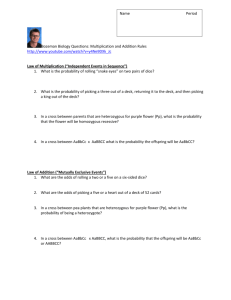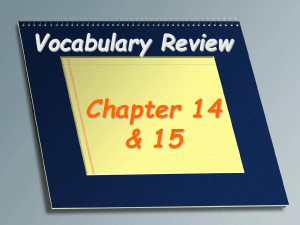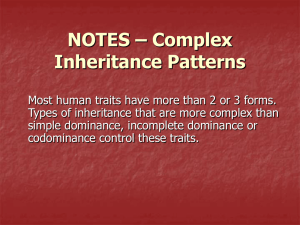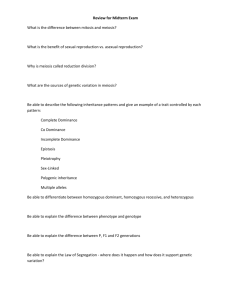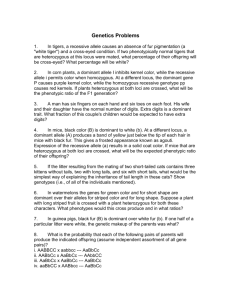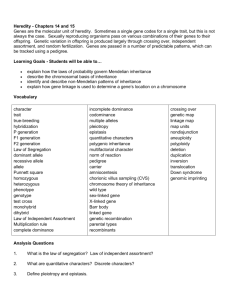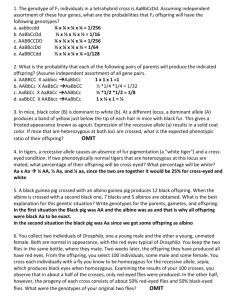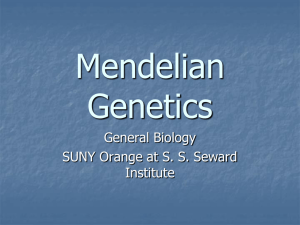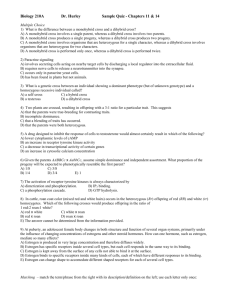Genetics
advertisement
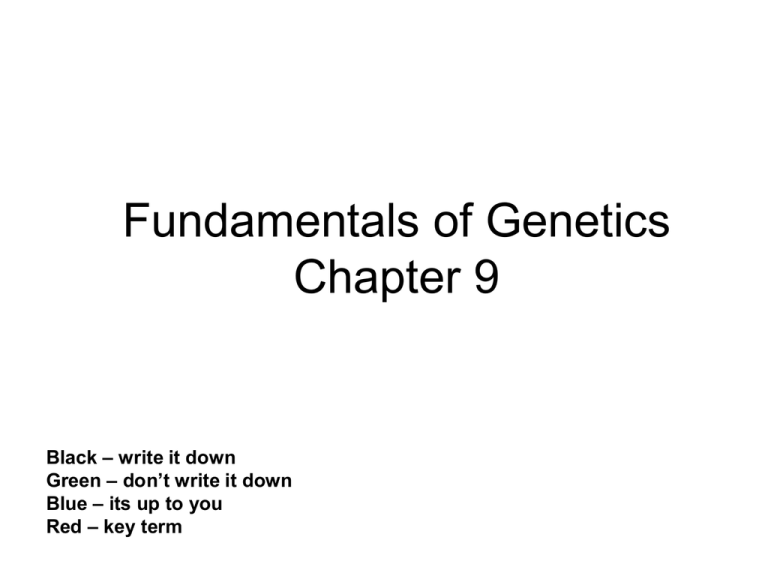
Fundamentals of Genetics Chapter 9 Black – write it down Green – don’t write it down Blue – its up to you Red – key term Genetics Goals • Be able to explain the relationship between genes, alleles, and traits • Be able to distinguish between a species’ genotype and phenotype • Be able to use a Punnett square to calculate the probability of each phenotype and genotype given a set of parents • Know the three laws of genetics 2-25-10 What is Genetics? • the scientific study of heredity; characteristics and how they are inherited, for ex. nose shape. UMBUKU Lizard LIGER ZEEDONK Gregor Mendel - Austrian Monk, famous for his work with pea plants. Father of Genetics chose traits that did not appear to blend the first to follow single traits from generation to generation • trait - specific characteristic that varies from one individual to another • true-breeding (purebred) plants - always produce offspring identical to themselves. • Hybrids - offspring from parents with different traits. • Alleles - different forms of a gene Genes – a short segment of DNA on a chromosome; contains the instructions for a single trait Molecular genetics – the study of the structure and function of chromosomes and genes The Principle of Dominance • Dominant alleles always expressed – Ex: brown eyes are dominant. • 2 brown alleles = brown eyes • 1 brown allele and 1 blue allele = brown eyes • Recessive alleles - only expressed if both alleles are recessive – Ex: blue eyes are recessive • 2 blue alleles = blue eyes • Law of Segregation Each individual has a pair of factors controlling each trait, one inherited from each biological parent. During the formation of gametes (sex cells) these two factors separate. Only one ends up in each sex cell. • The Law of Independent Assortment genes for different traits can separate on their own during the creation of gametes Ex 1: The heterozygous parents of the F1 generation have two alleles for the gene in question, and can pass one or the other, but not both, to their offspring. heterozygous parent gametes gene A a Homologous chromosomes A a Ex. 2: the homozygous parents in the P generation can pass one kind of allele to their offspring. homozygous parent gametes gene A A Homologous chromosomes A A • Homozygous – both alleles of a pair are alike (BB) – Purebred • Heterozygous – two alleles in the pair are different (Bb) – Hybrid • Genotype – genetic makeup (BB, Bb, bb) • Phenotype – physical characteristic (eyecolor, haircolor etc.) Students should use book here Genetic Generations • P generation – pure-bred parents are crossed • F1 generation – offspring of P generation selfpollinate • F2 generation – offspring of the F1 generation RR rr pollen Parental generation (P) pollen cross-fertilize true-breeding, purple-flowered plant true-breeding, white-flowered plant Rr First-generation offspring (F1) Punnett Squares • Diagram used to predict genetic crosses. • Individuals with identical alleles are called homozygous • Individuals with different alleles are called heterozygous How to use Punnett Squares 1. 2. 3. 4. Key: use a letter to represent each allele Cross: the genotypes of the parents. Punnet square Write the genotype: list all possible genotypes, then the fractions and percents shown in the Punnet square 5. Phenotypes: show all, with fractions and percents. Probability & Genetics • Probability - likelihood that something will happen. – used to predict the outcomes of genetic crosses – ex: penny – 2 possible outcomes, heads or tails 3.1.10 Predicting Results in Monohybrid crosses • Monohybrid – only one characteristic is studied – Mono means one • Genotypic Ratio – ratio of the genotypes in offspring • Phenotypic ratio – ratio of offspring’s phenotypes • Testcross – individual of unknown genotype is crossed with a homozygous recessive individual • Monohybrids have 2 possible phenotypes, 3 possible genotypes Trait 1: Dominant-Recessive - Dominant trait - shows up if present - Recessive trait - shows up if dom. trait not present - Dominant trait – capitalize - Ex: R for red - Recessive trait – lowercase - Ex: r for white - 3 genotypes, 2 phenotypes Trait Seed shape Seed color Pod shape Pod color Dominant form Recessive form smooth wrinkled yellow green inflated constricted green yellow purple white at leaf junctions at tips of branches tall (1.8 to 2 meters) dwarf (0.2 to 0.4 meters) Flower color Flower location Plant size Trait 2: Incomplete Dominance one allele is not completely dominant over the other. - Colors mix because neither is completely dominant - Both letters for genotype are capitalized - 3 genotypes, 3 phenotypes RR – Red, RW – Pink, WW – White Ex: Pink flower X Pink flower produce White-, pink-, and red-flowers in a 1:2:1 ratio 3.2.10 p 184 Incomplete dominance example R1R1 or RR = red R2R2 or WW = white R1R2 or RW = pink (there are multiple ways of writing the genotype; we will only use the capital letters like the previous slide) Trait 3: Codominance Both alleles contribute to the phenotype. Examples: Black cat x white cat = black and white cat Roan horse Red cow X White Cow = Roan Cow Dihybrid Cross - Two pairs of contrasting traits Ex: color and shape for peas 3.4.10 Punnett Squares: Monohybrid & Dihybrid Crosses Use the FOIL method: First Outer Inner Last http://nature.ca/genome/04/041/041_e.cfm Example Dihybrid Cross • In guinea pigs, the allele for short hair (S) is dominant to long hair (s), and the allele for black hair (B) is dominant over the allele for brown hair (b). What is the probable offspring phenotype ratio for a cross involving two parents that are heterozygotes for both traits? Example Dihybrid • • • • • Short hair = dominant = SS or Ss Long Hair = recessive = ss Black coat = dominant = BB or Bb Brown coat = recessive = bb SsBb x SsBb (gametes done by the FOIL method: First, Outer, Inner, Last) – SB, Sb, sB, sb and SB, Sb, sB, sb Answer the Question • What is the probable offspring phenotype ratio for a cross involving two parents that are heterozygotes for both traits? – 9/16 Black, short coats – 3/16 Black, long coats – 3/16 Brown, short coats – 1/16 Brown, long coats March 5, Friday • Review: chromosomes • sex linked genes • pedigrees http://www.biology.arizona.edu/Mendelian_genetics/problem_sets/sex_link ed_inheritance/sex_linked_inheritance.html Chapter 12: Inheritance Patterns and Human Genetics Chromosomes Autosomes - non-sex chromosomes. - Humans have 22 pairs Sex Chromosomes - Genetic information that determines gender of organism; humans have 1 pair - Females XX - males XY Karyotype 22 pairs of Autosomes + 1 pair sex chromosomes = a total of 23 pairs Objectives for X-linked traits: • Know males have sex-linked traits more often and why • Know what a carrier is • calculate inheritance using Punnett square • give examples Traits covered so far: On Autosomes 1: Dominant-Recessive traits 2: Incomplete Dominant traits 3: Codominant traits Now: On Sex Chromosome 4: X-linked traits Trait 4: X-linked Traits • X-linked recessive traits more common in males • Female carrier has a recessive allele hidden by the dominant allele • Ex: – Baldness – Hemophilia – Color blindness Examples: Healthy is dominant (A = normal vision): • Female: XAXA, XAXa, XaXA - 75% • Male: XAY – 50% Diseased is recessive (a = colorblind) • Female: XaXa - 25% • male XaY – 50% ColorBlindness When would a female have a sex linked trait? http://74.125.47.132/search?q=cache:rWFtNrPOFNoJ:www.austincc.edu/mlt/mdfund/mdfund_unit2pedi gree_genetics.ppt+sex+linked+traits+worksheet&cd=7&hl=en&ct=clnk&gl=us Pedigree A diagram that shows how a trait is inherited over several generations Pedigree • Circles – stand for females • Squares – stand for males • Colored circle or square – affected by recessive trait • Half filled in - carrier Trait 5: Multiple Alleles - determined by a single gene that has at least four different alleles. Ex: rabbit fur, blood types, parakeet color You will need to learn the blood types Genotype AO http://nobelprize.org/educational_games/medicine/landsteiner/index.html BO AB OO http://www.biology.arizona.edu/human_bio/problem_sets/blood_types/markers.html YYBB or YyBb yyBB or yyBb YYbb or Yybb yybb Trait 6: Polygenic traits – Several genes control the trait (more than two alleles) Ex: Skin color in humans. aBc aBC Abc AbC ABc ABC abc abC ABC AABBCC AABBCc AABbCC AABbCc AaBBCC AaBBCc AaBbCC AaBbCc ABc AABBCc AbC AABbCC AABbCc AAbbCC AAbbCc AaBbCC AaBbCc AabbCC AabbCc Abc AABbCc aBC AaBBCC AaBBCc AaBbCC AaBbCc aaBBCC aaBBCc aaBbCC aaBbCc aBc AaBBCc AaBBcc AaBbCc AaBbcc aaBBCc aaBBcc aaBbCc aaBbcc abC AaBbCC AaBbCc AabbCC AabbCc aaBbCC aaBbCc aabbCC aabbCc abc AaBbCc AaBbcc AabbCc Aabbcc aaBbCc aaBbcc http://biology.clc.uc.edu/Courses/Bio105/geneprob.htm aabbCc aabbcc AABBcc AABbcc AABbCc AAbbCc AABbcc AAbbcc AaBBCc AaBbCc AaBBcc AaBbcc AaBbCc AabbCc AaBbcc Aabbcc Review • Know this about the 6 Traits: • 1: Dominant-Recessive traits – only one trait is expressed • 2: Incomplete Dominant traits – traits are mixed (red + white = pink) • 3: Codominant traits – both traits are shown separately (patches) • 4: X-linked traits – on X-chromosome, if recessive, occurs most often in males • 5: Multiple Alleles - single gene, but at least 4 alleles; know how to find blood type • 6: Polygenic – more than one gene WHAT IS A MUTATION? March 8 A Mutation is: A change in the nucleotide-base sequence of a gene or DNA molecule Objectives: • Recognize germ cell & somatic cell mutations • Differences between chromosome & point mutations • Know why mutations are important, & be able to give examples of mutations • Germ cell mutation – occurs in gametes, can be inherited • Somatic-cell mutations – take place in body cells, affect the organism; not inherited. Ex: skin cancer, leukemia • Lethal mutations – cause death, often before birth. Chromosome mutations Deletion- piece of a chromosome breaks off Inversion – chromosome segment breaks off, flips around and reattaches Translocation – piece of a chromosome breaks off and reattaches to a nonhomologous chromosome. Nondisjunction – chromosome fails to separate from its homologue during meiosis Point mutations Substitution – one nucleotide is replaced with another Insertion mutation - one or more nucleotides is added Frameshift mutation – deletion or insertion of nucleotides, makes later amino acids change Disorders • • • • Down syndrome: trisomy 21 (47) Klinefelter syndrome: XXY (47) Turner’s syndrome: X (45) Cri du chat – deletion in chromosome 5. mental retardation, early death • Oculotaneous albinism – caused by mutation in one of four genes • Pick one example for your notes Some scientists credit mutations with being the driving force behind evolution, by which they mean progressive changes through which organisms, especially humans, become more advanced. Unfortunately for these scientists, mutations tend to either be a loss of information (frameshift mutation), an extra copy of pre-existing information, or rarely a small, random and benign (non-harmful) change in DNA. Most mutations are far from benign, and are the source of various birth defects, genetic illnesses and cancer. “Oculocutaneous albinism 2” caused by mutation in a gene on chromosome 15 Albinism is the result of a loss of genetic information, specifically pigments or coloring Animals or people born with additional body parts – additional copies of pre-existing information END GENETICS Cloning • http://learn.genetics.utah.edu/content/tech/ cloning/clickandclone/ http://www.youtube.com/watch?v=IUKslRdPvbY&feature=related • http://www.youtube.com/watch?v=zP2m95 JAD4g&feature=related • http://www.sumanasinc.com/webcontent/a nimations/content/mendel/mendel.html http://www.nburlington.com/ourpages/users/alanoue/Bio_handouts.htm#Genetics http://web.archive.org/web/19971023004508/http://nesen.unl.edu/methods/biodemo.html#demo13 http://www.upt.pitt.edu/ntress/Bio1_Lab_Manual_New/molecular_biology_exercises.htm http://www.apsnet.org/education/feature/ancientdna/top.htm • Mosaicism http://www.vivo.colostate.edu/hbooks/gene tics/medgen/chromo/mosaics.html http://learn.genetics.utah.edu/ Mosaicism a pattern of development in which an organism consists of two sets of cells that differ according to which X chromosome is activated. • Heterochromatic eyes • Fred and Wilma both have smooth hairlines. Their daughter, Pebbles, has a pointed (“widow’s peak”) hairline. Which is dominant: smooth or pointed hairline? How do you know? • Penelope has small, attached earlobes. Armando has larger, free earlobes. All four of their children have large, free earlobes. Which is dominant: free or attached earlobes? How do you know?
